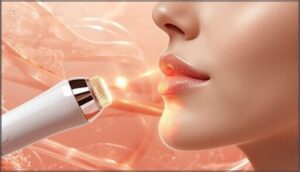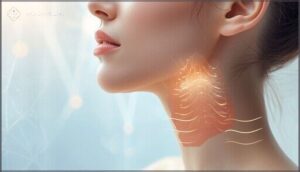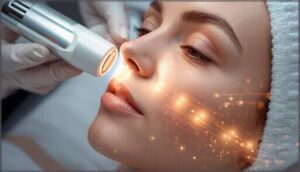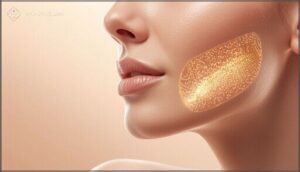This site is supported by our readers. We may earn a commission, at no cost to you, if you purchase through links.
Your skin doesn’t stop making collagen overnight, but somewhere between your thirtieth birthday and your fortieth, production slows enough that your mirror starts telling a different story. Fine lines deepen, jawlines soften, and that snug elasticity you took for granted begins to slip away.
Non-invasive skin tightening treatments offer a middle ground between expensive creams that don’t deliver and surgical procedures you aren’t ready to undergo. These technologies use controlled heat energy to trigger your body’s natural repair mechanisms, coaxing dormant collagen production back to life without incisions or extended recovery periods.
The challenge lies in choosing the right approach for your specific concerns, since radiofrequency, ultrasound, and combination devices each work differently beneath your skin’s surface.
Table Of Contents
- Key Takeaways
- How Non-Invasive Skin Tightening Works
- Key Technologies for Skin Tightening
- Comparing Popular Non-Invasive Treatments
- Benefits of Non-Invasive Skin Tightening
- Limitations and Candidacy Considerations
- Choosing The Right Provider and Device
- Costs, Maintenance, and Long-Term Results
- Frequently Asked Questions (FAQs)
- Conclusion
Key Takeaways
- Non-invasive skin tightening uses controlled heat (60–70°C) to trigger immediate collagen contraction and stimulate your body’s natural production of fresh collagen and elastin over 3–6 months, offering visible firming without surgery or extended recovery.
- Radiofrequency works across all skin tones with minimal risk, ultrasound (like Ultherapy) reaches deeper layers for lifting effects, and RF microneedling delivers energy directly into the dermis—each technology targets different depths and concerns, so matching the right one to your specific laxity matters.
- These treatments work best for mild-to-moderate sagging in people aged 30–60 with realistic expectations, but they can’t replace surgery for severe skin laxity, excess tissue, or dramatic transformations.
- Results typically last 6–24 months depending on the technology, with costs ranging from $1,000–$5,000 per session, and factors like your age, sun protection habits, and lifestyle choices significantly impact how long improvements stick around.
How Non-Invasive Skin Tightening Works
Non-invasive skin tightening works by delivering controlled heat energy into the deeper layers of your skin, which triggers your body’s natural healing response. This process causes existing collagen fibers to contract immediately while also stimulating fresh collagen and elastin production over time.
To understand how these treatments achieve visible firming and lifting effects, let’s break down the science behind the technology.
Mechanisms of Collagen and Elastin Stimulation
When energy-based devices heat your skin, they trigger thermal denaturation of collagen fibers, kickstarting a healing cascade. Your fibroblasts respond by ramping up collagen and elastin production through gene upregulation.
Enhanced blood flow delivers nutrients that fuel fibroblast activity, while matrix remodeling continues for months. This controlled damage fundamentally tricks your body into rebuilding firmer, more youthful skin from within.
Radiofrequency treatments are known to stimulate collagen contraction effectively.
Role of Heat Energy in Skin Firming
Thermal injury is at the heart of these treatments—targeted heat between 60°C and 70°C causes collagen denaturation, immediately tightening existing fibers. Push past 46°C for three minutes, and you’ll trigger heat-shock proteins that launch neocollagenesis.
Controlled heat between 60°C and 70°C triggers immediate collagen tightening and launches your body’s natural rebuilding response
Radiofrequency and ultrasound deliver this controlled damage precisely, even reaching subcutaneous adipocyte destruction. Your skin doesn’t just contract; it rebuilds stronger elastin networks over the following weeks.
These treatments offer alternatives to surgery for addressing skin laxity.
Areas Commonly Treated (Face, Neck, Body)
So where can you actually use these nonsurgical skin tightening treatments? The options span from head to toe:
- Facial tightening zones (cheeks, jawline, brow)
- Neck contouring for submental laxity
- Décolletage rejuvenation addressing chest lines
- Abdominal tightening post-pregnancy or weight loss
- Limb contouring on arms, thighs, and buttocks
Facial and neck rejuvenation remain the most popular, though body contouring for skin laxity is gaining ground fast.
Key Technologies for Skin Tightening
Not all skin tightening technologies work the same way, and understanding your options can help you feel confident about what’s right for your skin. Each approach uses a different type of energy to stimulate collagen production beneath the surface.
Here’s a closer look at the key technologies you’ll encounter.
Radiofrequency (RF) Treatments
Radiofrequency RF therapy works by delivering controlled electromagnetic waves deep into your skin, heating tissue to ideal temperatures between 43°C and 44°C. This triggers your body’s natural collagen production and fibroblast activation.
| Feature | Specification | Benefit |
|---|---|---|
| Penetration Depth | 4.37–25.0 mm | Treats multiple skin layers |
| Treatment Parameters | 0.5–1 MHz frequency | Precise energy delivery |
| RF Safety Profile | FDA-cleared devices | Minimal adverse effects |
| Long-Term Efficacy | 70–75% improvement | Sustained results at 3 months |
| Combination Therapies | RF + microneedling | Enhanced collagen stimulation |
Radiofrequency skin tightening and radiofrequency microneedling offer adaptable options. Post-treatment care is straightforward, and radiofrequency RF treatments work across all skin tones.
Ultrasound-Based Procedures
When you’re exploring nonsurgical skin tightening options, ultrasound-based procedures like Ultherapy deliver focused energy to precise depths beneath your skin’s surface. HIFU efficacy studies show 18–30% improvement in facial laxity, while MFU applications target mild-to-moderate concerns effectively.
Key treatment parameters to understand:
- Focal depths range from 1.5 mm to 4.5 mm depending on anatomy
- Ultrasound safety profile shows fewer than 5% experience temporary redness
- Cost analysis reveals sessions averaging $993, ranging $770–$1,862
Ultrasound skin tightening results generally emerge within 2–3 months and can last up to two years.
Intense Pulsed Light (IPL) and Combination Devices
Intense pulsed light (IPL) therapy works through fascinating IPL mechanisms—wavelengths between 530–1200 nm penetrate your dermis, triggering new collagen and elastin production.
When paired with radiofrequency in IPL/RF combination treatments, you get combination synergy that tackles both pigmentation and deeper structural concerns simultaneously.
Efficacy outcomes show 82% of patients notice improvement within one month. The safety profile suits lighter skin tones best. Longevity maintenance requires sessions every 6–12 months.
RF Microneedling
Because radiofrequency microneedling delivers heat directly into your dermis through tiny needles, it supercharges collagen production beyond what traditional microneedling achieves alone.
Efficacy outcomes are impressive—studies show a 49% reduction in wrinkle severity. The safety profile remains excellent across all skin types, making ideal candidates those over 30 with moderate laxity.
Longevity results last 12–18 months, though treatment costs generally range $500–$2,500 per session.
Comparing Popular Non-Invasive Treatments
Now that you understand the main technologies behind non-invasive skin tightening, let’s look at how specific treatments stack up against each other.
Your ideal choice depends on your skin concerns, tolerance for downtime, and the results you’re hoping to achieve.
Here’s a breakdown of the most popular options.
Ultherapy Vs. Thermage FLX
When you’re deciding between Ultherapy and Thermage FLX, understanding how they differ helps you pick what fits your goals.
- Treatment Depth: Ultherapy uses focused ultrasound skin tightening to reach the SMAS layer at 4.5 mm, while Thermage relies on radiofrequency to heat up to 4.0 mm for skin tightening.
- Clinical Efficacy: Over 75% report satisfaction with Ultherapy at 3 months; Thermage FLX shows improvement rates above earlier models.
- Patient Comfort: Thermage FLX offers integrated cooling, making it less painful for most.
- Result Duration: Both last around 12 months, though Thermage may extend slightly longer.
- Combination Therapy: Pairing Thermage for immediate tightening with Ultherapy for deeper lifting addresses pronounced laxity effectively.
Venus Versa and VelaShape
Venus Versa and VelaShape are FDA-cleared nonsurgical skin tightening treatments that target body contouring and mild laxity. Venus Versa uses Multi-Polar RF and Pulsed Electro Magnetic Fields to stimulate collagen production, while VelaShape combines Bi-Polar RF, infrared light, vacuum, and massage.
Clinical efficacy shows VelaShape reducing abdomen circumference by 1.4 cm at three months. Both noninvasive procedures offer safe treatment mechanisms across multiple areas with minimal downtime, though maintenance outcomes require periodic sessions.
RF Microneedling Vs. Traditional RF
When your skin needs a deeper reach, RF microneedling delivers radiofrequency energy through tiny needles for enhanced dermal penetration and collagen remodeling. Traditional radiofrequency RF therapy works from the surface, limiting depth.
Here’s the downtime comparison:
- RF microneedling: 24–48 hours recovery, 1–3 sessions needed
- Traditional RF: under 24 hours, 4–6 sessions required
- Adverse events: both show minimal risk when properly performed
- Treatment cost: RF microneedling runs $800–$2,500 per session versus $600–$1,200 for traditional radiofrequency
Benefits of Non-Invasive Skin Tightening
Non-invasive skin tightening has gained traction because it works without putting you under the knife. You get visible improvements in skin firmness and texture, all while sidestepping the risks and recovery time that come with surgery.
Let’s break down what makes these treatments worth considering.
Lifting and Firming Effects
When you’re weighing nonsurgical skin tightening options, you’ll see visible improvements within weeks—studies show over 80% of patients notice noticeable lifting by the three-month mark.
Treatment timeline matters: boosting collagen production takes time, but objective measurements confirm 35–40% firmer skin after RF therapy.
Long-term firmness and improving skin elasticity drive patient satisfaction, with noninvasive cosmetic procedures delivering real results without surgery.
Minimal Downtime and Recovery
You’ll resume your routine the same day—over 83% of noninvasive treatments let you get back to normal within one or two days. Most nonsurgical skin tightening sessions wrap up in under an hour, so minimizing downtime becomes reality, not just a sales pitch.
Immediate effects like mild warmth fade fast, and post-treatment care stays simple: skip strenuous workouts for 48 hours, then carry on.
Safety Profile and Side Effects
Beyond the quick return to daily life, noninvasive treatments carry minimal risk. Systematic reviews show fewer than 5% of patients face notable side effects. You might see temporary redness or mild swelling that clears within hours to two days.
Serious complications like nerve irritation or pigment changes remain exceptionally rare when qualified providers use FDA-cleared devices, making these minimally invasive procedures a low-stakes option for firming skin.
Suitability for Different Skin Types
Different complexions respond to these antiaging technologies in distinct ways. Radiofrequency stands out for its excellent RF safety profile across melanin-rich skin—you won’t face the hyperpigmentation risks common with older lasers. Ultrasound effectiveness matches light and dark Fitzpatrick skin types equally well, with 75–85% improvement at six months. Individualized protocols matter:
- Lower energy settings prevent thermal injury in darker tones
- RF minimizes epidermal heating, protecting against discoloration
- Ultrasound carries under 5% minor side effects across all types
- Fractional RF suits Fitzpatrick VI with less than 2% adverse events
- Over 80% satisfaction reported for skin types III–VI
Providers tailor device selection to your unique skin texture and skin laxity concerns, ensuring safe skin rejuvenation and skin tightening results regardless of background.
Limitations and Candidacy Considerations
Non-invasive skin tightening isn’t a one-size-fits-all solution, and knowing whether you’re a good candidate can save you time, money, and disappointment. These treatments work best for specific types of skin laxity, but they won’t deliver the same results as surgery for everyone.
Here’s what you need to know about who benefits most, what these procedures can realistically address, and when they might fall short of your expectations.
Ideal Candidates for Treatment
You’re an ideal candidate if you’re between 30 and 60 with mild skin laxity—not severe sagging—and within 30% of your ideal weight. Your BMI should stay under 30, and stable health status matters. Nonsurgical procedures work across all skin tones, making these antiaging cosmetic procedures accessible regardless of melanin concentration. Realistic expectations about gradual skin aging improvements, not dramatic transformations, set you up for satisfaction.
| Criteria | Ideal Range |
|---|---|
| Age Parameters | 30–60 years |
| BMI Threshold | Under 30 |
| Skin Laxity | Mild to moderate |
Effectiveness on Mild to Moderate Laxity
When you’re dealing with modest laxity, nonsurgical skin tightening delivers measurable change. Radiofrequency skin tightening and ultrasound skin tightening stimulate collagen production, yielding meaningful—if not surgical-grade—improvements:
- Laxity improvement rate reaches 16% with fractional RF in controlled trials
- Treatment result durability extends up to 12 months post-procedure
- Patient satisfaction scores show 93% approval in mild cases
- Objective tissue changes include increased collagen density on histology
- Modality comparative efficacy: RF achieves 37% of facelift-level tightening
Your skin laxity responds best when it’s not too severe.
Limitations for Severe Skin Sagging
When severe skin laxity sets in—pronounced jowling, extensive redundant skin after weight loss, or grade 3–4 sagging—nonsurgical skin tightening falls short.
Trials document limited improvement: only 10–20% patient satisfaction, less than 20% objective change in loose skin. You’ll likely need surgical alternatives.
Expect failure rates of 65–80%, high revision procedure requests, and patient expectations that won’t align with reality. Treatments for loose skin can’t remove substantial excess tissue.
Choosing The Right Provider and Device
Picking the right provider and device isn’t just about reading online reviews or choosing the closest med spa. Your results, safety, and satisfaction depend on working with someone who actually knows what they’re doing and uses equipment that’s been properly vetted.
Here’s what you need to look for when making your decision.
Importance of Qualified Practitioners
When you’re choosing a skin tightening provider, don’t skip the credential verification step. Board-certified practitioners follow regulatory standards that minimize adverse events and protect patient satisfaction. Ethical oversight matters because inadequately trained individuals offering aesthetic treatments can cause burns, scarring, or inconsistent results.
In dermatology and cosmetic treatments, proper qualifications aren’t just paperwork—they’re your safety net against complications.
FDA-Cleared Technologies
FDA-cleared technologies aren’t all created equal. Most skin tightening devices—RF, ultrasound, and RF microneedling—receive marketing authorization through the 510(k) pathway as Class II medical devices.
You want proof a device works safely? Check the MAUDE Database for post-market data on adverse events.
Device classifications matter because they tell you whether nonsurgical body contouring options meet federal safety benchmarks before touching your skin.
Consultation and Personalized Treatment Plans
Your consultation should include a thorough skin assessment—documented in 96% of sessions—to determine if nonsurgical skin treatments match your goals. Treatment customization matters: 89% of patients receive individualized plans based on age, skin type, and laxity severity.
Informed consent covering risks, benefits of skin tightening, and candidacy evaluation happens in 97% of accredited clinics. Outcome tracking through photography and measurements ensures your skin tightening procedures deliver results.
Costs, Maintenance, and Long-Term Results
You’ve picked your treatment and found the right provider—now let’s talk about what it’ll actually cost you, and how long those results will stick around. Non-invasive skin tightening isn’t a one-and-done deal for most people, and your age, lifestyle, and the specific technology you choose all play a role in how things pan out.
Here’s what you need to know about pricing, maintenance schedules, and the real-world factors that’ll affect your outcome.
Typical Pricing by Treatment Type
How much can you expect to invest in smoother, firmer skin? The cost of skin tightening varies widely depending on the aesthetic procedures you choose:
- Ultherapy Cost: $2,300–$5,000 per session for face and neck
- Thermage Pricing: $1,230–$4,000 for full-face treatments
- RF Treatments: $1,000–$4,000 per session
- IPL Pricing and Thread Lifts: $126–$5,658 depending on complexity
Understanding nonsurgical skin treatments pricing helps you budget for the benefits of skin tightening procedures ahead.
Maintenance and Longevity of Results
Results from non-invasive skin tightening can last between six months and two years, depending on the technology you choose. Ultrasound and plasma-based treatments often deliver extended longevity—up to three years—while radiofrequency usually requires maintenance every six to twelve months.
Treatment intervals vary by area; thicker skin holds results longer. Combination regimens that stimulate collagen and elastin production may improve skin firmness and reduce how often you’ll need touch-ups.
Factors Affecting Outcomes (Age, Lifestyle)
Your age and lifestyle choices shape how well skin tightening works. If you’re between 35 and 59, you’ll likely see stronger results, though skin hydration drops about 5 units per year after treatment. Preventative timing—starting in your late twenties or early thirties—helps maintain skin elasticity before significant skin laxity and aging set in.
Smoking, poor sleep, and chronic health comorbidities reduce skin aging and elasticity improvements, while UV protection, balanced nutrition, and regular exercise support firmer outcomes.
Frequently Asked Questions (FAQs)
How soon can I see visible results?
You’ll notice initial tightening from collagen contraction within days, but the real transformation unfolds gradually.
Short-term progress appears around 2–4 weeks, medium-term effects peak at 3 months, and long-term outcomes reach their fullest extent by 6 months as skin elasticity improves.
Are treatments painful or do they require anesthesia?
Think of discomfort like a warm breeze—noticeable but not distressing. Most radiofrequency and ultrasound treatments don’t require anesthesia, though topical numbing agents minimize any sensation.
Patient satisfaction remains high, with minimal downtime and manageable side effects.
Can I combine treatments with other cosmetic procedures?
You can safely combine skin tightening with dermal fillers, neuromodulators, or laser resurfacing.
Treatment sequencing matters—proper intervals between procedures minimize adverse events, reduce downtime, and create synergistic effects for complete facial rejuvenation.
How many sessions are needed for optimal results?
Most radiofrequency protocols require four to six sessions spaced one to two weeks apart, while ultrasound treatments like Ultherapy generally achieve best collagen stimulation in just one session, with maintenance every six to twelve months.
What should I avoid before and after treatment?
You’ll need to skip harsh skincare products, sun exposure, and blood-thinning medications beforehand.
After treatment, avoid strenuous physical activities, additional procedures, and direct sunlight while following your ideal skin care regimen for best recovery.
Conclusion
Here’s what separates wishful thinking from measurable change: your commitment to evidence-based non-invasive skin tightening treatments performed by qualified practitioners. You’ve seen how radiofrequency, ultrasound, and microneedling each target collagen differently, and you understand that realistic expectations matter more than marketing promises.
Your skin won’t rewind decades, but it can regain firmness you thought was gone. The question isn’t whether these technologies work—it’s whether you’re ready to invest in the right one for your concerns.
- https://www.precedenceresearch.com/non-surgical-skin-tightening-market
- https://www.psmarketresearch.com/market-analysis/non-surgical-skin-tightening-market
- https://www.cartessaaesthetics.com/blog/the-rise-of-non-invasive-skin-tightening-meeting-patient-demand-with-advanced-devices
- https://www.oaepublish.com/articles/2347-9264.2021.60
- https://www.americanboardcosmeticsurgery.org/procedure-learning-center/non-surgical-procedures/skin-tightening/













